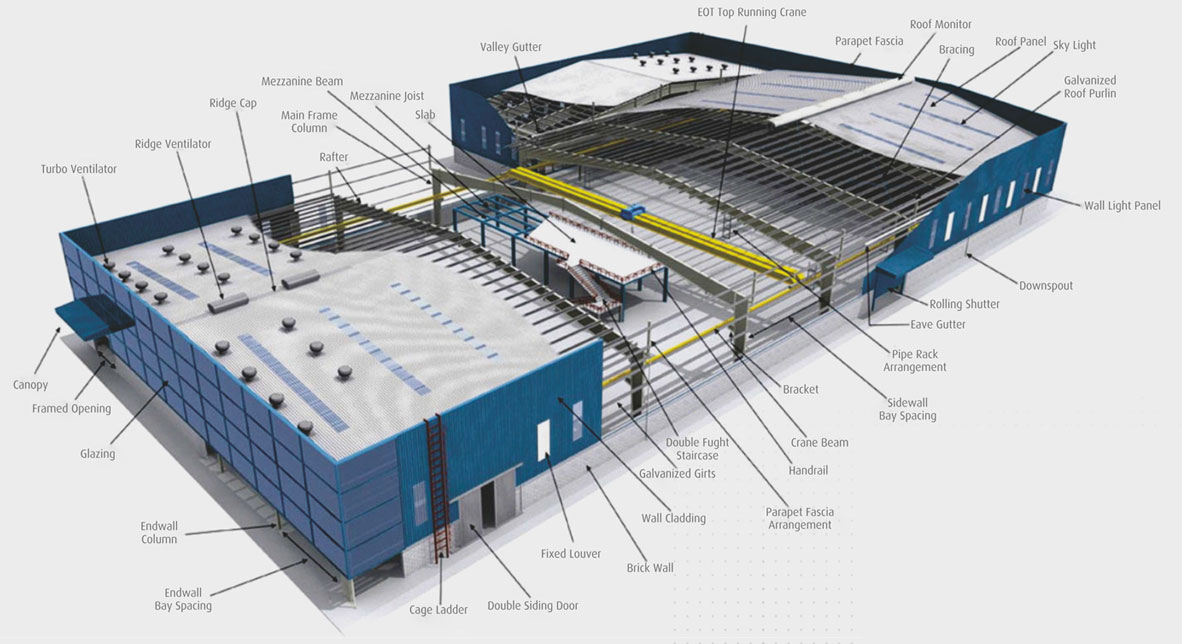Pre Engineered Steel Buildings |
Conventional Fabrication & Erection Structural Steel Buildings |
1) Design Criteria
AISC / MBMA / AWS |
1) Design Criteria
AISC/ AWS/ JIS/ DIN/ BS |
2) Design
Quick and efficient since standardization of pre-engineered steel buildings has significantly reduced design time. Basic designs are used over Specialized computer analysis and design programs reduce design time and optimize material required. Drafting is also computerized with minimal manual drawings. Design, detail drawings and erection drawings are supplied free of charge by the manufacturer. Approval drawings may be prepared within ten days to 3 weeks. Consultant in-house design and drafting design is significantly reduced, allowing more time for coordination and review, and increasing margins in design fee savings. |
2) Design
Each Conventional Fabrication & Erection steel structure is designed from scratch by the consultant, with fewer design aids available to the Engineer. Maximum engineering required on every project. Generalized computer analysis programs require extensive input/output and design iterations. Drafting is manual or only partially automated.Much Consultant time and expense is devoted to design and drafting, as well as coordination and review. |
3) Weight
About 30% lighter through the efficient use of steel. Primary framing members are designed with tapered built-up plate sections with the most steel in the areas of highest stress, using high strength steel.Secondary members are light gage cold formed “Z” or “C” shaped members. Members are roll-formed for minimum weight and labor cost. |
3) Weight
Steel member sizes must be selected from standard hot rolled sections, which in many cases are heavier than what is actually required by design. Members are the same cross-section along the entire length, regardless of local stress magnitude Secondary members are from standard hot rolled “I” and “C” sections. In many cases members are heavier than required, and therefore are not as economical as cold formed members. |
4) Base Material
Rigid Building pre-engineered steel buildings system uses almost all steel to meet 50,000 P.S.l. minimum yield including the cladding. |
4) Base Material
In most of the cases (90%) Base Material is 36,000 P.S.I. minimum yield. |
5) Foundation
Simple design, easy to construct and lightweight. |
5) Foundation
Extensive heavy foundation required. |
6) Accessories (Windows, Doors, Ventilation)
Designed to fit the system, with standardized, interchangeable parts, including pre-designed flashing and trims.Mass produced for economy. All available with the building. |
6) Accessories (Windows, Doors, Ventilation)
Every project requires special design for accessories and special sourcing for each.Flashing and trims must be uniquely designed and fabricated. |
7) Delivery
Approximately 8 weeks |
7) Delivery
Average 5 to 6 months. |
8) Erection
Easy, fast, step by step. Erection costs and time are accurately known, based upon extensive experience with similar buildings. |
8) Erection
Slow, extensive field labor required. Typically 20% more expensive than pre-engineered steel buildingss
In most of the cases, the erection cost and time are not estimated accurately. |
9) Architecture
Outstanding architectural design can be achieved at low cost. Conventional Fabrication & Erection wall and fascia materials, such as concrete, masonry and wood, can be utilized. |
9) Architecture
Special architectural design requires research and high cost. |
10) Overall Price
Price per square meter may be as much as 40% lower than Conventional Fabrication & Erection steel. |
10) Overall Price
High price per square meter. |
11) Sourcing and Coordination
Building is supplied complete with cladding and all accessories, including erection if required, all from one source of supply. |
11) Sourcing and Coordination
Many sources of supply. Project Management time required to co-ordinate suppliers and sub-contractors. |
12) Changes
Very flexible, tailor made, accepts changes and revisions easily. Future expansion simple, easy and cost effective. One supplier to coordinate changes. |
12) Changes
Changes, revisions and additions can be difficult due to extensive redesign and coordination among suppliers and subcontractors. |
13) Responsibility
Single source of supply results in total responsibility for one supplier, including design liability. |
13) Responsibility
Multiple responsibilities can result in questions of who is responsible when components do not fit properly, insufficient material is supplied, or materials fail to perform, particularly at supplier interfaces. The Consultant carries total design liability. |
14) Performance
All components have been specified and designed specifically to act together as a system, for maximum efficiency, precise fitup, and performance in the field.The experience with similar buildings in actual field conditions world-wide has resulted in design improvements over time which allow dependable prediction of performance. |
14) Performance
Components are designed in general for possible use in many alternative configurations. Design and detailing errors are possible in assembling diverse components into unique buildings.Each building design is unique, so prediction of how components will perform together is uncertain. Materials which have performed well in some climates may not in other environments. |

